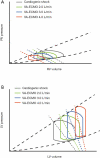Hemodynamic monitoring in patients with venoarterial extracorporeal membrane oxygenation
- PMID: 32647717
- PMCID: PMC7333156
- DOI: 10.21037/atm.2020.03.186
Hemodynamic monitoring in patients with venoarterial extracorporeal membrane oxygenation
Abstract
Veno-arterial extracorporeal membrane oxygenation (VA-ECMO) is an effective mechanical circulatory support modality that rapidly restores systemic perfusion for circulatory failure in patients. Given the huge increase in VA-ECMO use, its optimal management depends on continuous and discrete hemodynamic monitoring. This article provides an overview of VA-ECMO pathophysiology, and the current state of the art in hemodynamic monitoring in patients with VA-ECMO.
Keywords: Perfusion; cardiac output (CO); echocardiography; microcirculation; shock; veno-arterial extracorporeal membrane oxygenation (VA-ECMO).
2020 Annals of Translational Medicine. All rights reserved.
Conflict of interest statement
Conflicts of Interest: All authors have completed the ICMJE uniform disclosure form (available at http://dx.doi.org/10.21037/atm.2020.03.186). The series “Hemodynamic Monitoring in Critically Ill Patients” was commissioned by the editorial office without any funding or sponsorship. GWT served as the unpaid Guest Editor of the series and serves as an unpaid Section Editor of Annals of Translational Medicine from May 2018 to Sep 2020. The other authors have no other conflicts of interest to declare.
Figures



References
Publication types
LinkOut - more resources
Full Text Sources
Other Literature Sources
